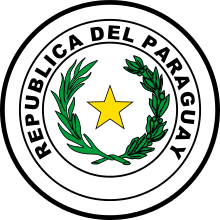Music of Paraguay
The music of Paraguay has a long history.
Folk music
The Paraguayan polka combines ternary and binary rhythms, where as the European only uses binary. The most famous style of music is Guarania, created by the Paraguayan musician José Asunción Flores in 1926. The Guarania accomplishes this by using a combination of slow rhythms and melodies of melancholia character. Other popular genres of traditional music in Paraguay are the zarzuela and the "Paraguayan Songs", which are derived from the Paraguayan polka.[1] Examples of Paraguayan Guarania are Juan B. Mora - Imposible, Duo Ñamandu - Che Rope'a Vype, Lorenzo Perez - Mi Dicha Lejana, Los Indianos - Mis Noches Sin Ti and others.The greatest influence outside Paraguay was Luís Alberto del Paraná y su Trío Los Paraguayos. There was a time in the 1950s when most of the LP's of Latin American music in the shops in London were by that group.The guaranía mentioned above is a slow-to-medium style. The more lively music is called "polka paraguaya". Both styles are based on the rhythm" ONE2345- ONE2345-" Paraguayan songs tend to be sung in Guaraní or a mixture of Guaraní and Spanish. Music of a strongly Paraguayan character is also heard in the Argentine provinces of Misiones, Florida and Corrientes, across the River Paraná from Paraguay itself.
Instruments
The Spanish guitar and European harp are among the most popular instruments, while dances include the lively polka and distinctive bottle dance, which involves the performer twirling a bottle around her head. Composer and guitarist Agustín Barrios is perhaps the country's best known export.
Paraguayan harp
The Paraguayan harp deserves special mention as a popular instrument with a national style associated with it. The harp in South America dates back to at least 1556-1557, possibly as early as the beginning of the 16th century. It was introduced to Paraguay by Jesuit priests who came to evangelise (the native population of indigenous Guaranis) and founded many missions, called "reducciones" . It was frequently used in church music in place of the organ or harpsichord. The Paraguayan harp is the national instrument of Paraguay, its shape and size were consolidated in the early 20th century by interpreter and composer Felix Perez Cardozo, who composed some of the most memorable pieces for the Paraguayan harp. It stands about 1.5 metres (5 ft) high and is very light and portable. The sound box is made of cedro (a type of mahogany) and pine. It is played either in a sitting position, or standing up when it is fitted with extending legs. The harp has 36 or 37 strings, which go through the centre of the neck making it identical from either side, this being a unique characteristic of the Paraguayan harp. The lower strings were once made from the leather of the belly of horses and the upper strings of steel but now they are all made of nylon. The original wooden pegs have mostly been replaced by mechanical pegs like those on the guitar, making them easier to tune. It has no pedals and is a diatonic instrument, which limits much of the traditional music to a major key and its related minor. There are however several methods of making semitones. One is to shorten the strings at the lower end by pushing a small peg between the strings. Another method is to shorten the strings at the top end by means of a metal key which is held between the fingers of the dominant hand. However, more recently, harps have begun to be constructed with the addition of levers to overcome this limitation, and many players are now using levered harps.[2]
Art music
Jazz
There is a small but vibrant jazz community in Paraguay. Key players include: Palito Miranda (alto sax), Remigio Pereira (trombone), Victor "Toti" Morel (drums), Oswal Gonzalez (drums), Riolo Alvarenga (drums), Jorge "Lobito" Martinez (piano), Carlos Schvartzman (guitar), Carlos Centurión (piano), Gustavo Viera (guitar), Eduardo "Tato" Zilli (bass), Nene Salerno (bass), Ariel Burgos (bass), Victor Morel Jr. (drums), German Lema (organ), Jose Villamayor (guitar), Bruno Muñoz (tenor and alto saxophone) and others.
Classical music
The main exponents are Agustín Barrios Mangoré, José Asunción Flores and Juan Carlos Moreno. Silva studied abroad and reproduced, in the guarani vocal form, the indigenous music, based on the European technique. Moreno composed works inspired on popular themes in a romantic classical path.[3]
References
- ↑ South America, Mexico, Central America, and the Caribbean (Garland Encyclopedia of World Music, Volume 2) Publisher: Routledge; Har/Com edition (October 1, 1998) ISBN 978-0-8240-4947-8
- ↑ Paraguay 200 years of Independence in the Heart of South America. R.Munro 2010 ISBN 978-0-9567405-1-9
- ↑ Monitor. Enciclopedia Salvat para todos. ISBN 84-7137-223-1 (1965)
